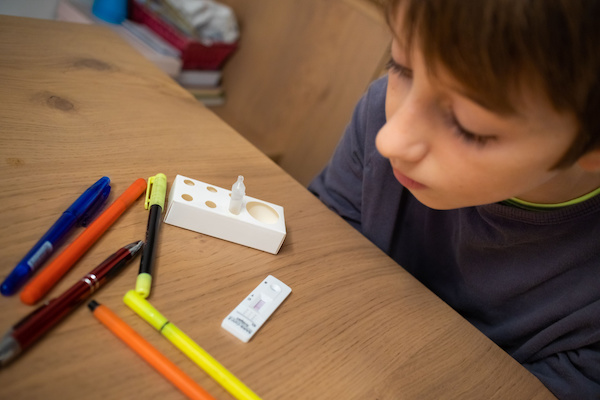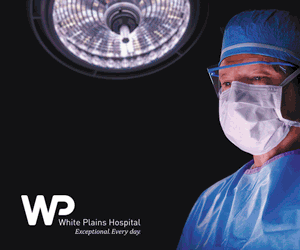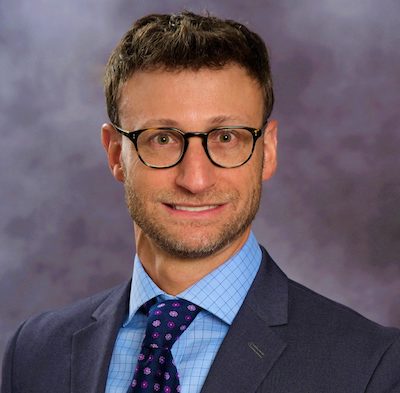When “Up Your Nose” Is to Be Taken Literally
- Details
- Written by Dr. Clare Dean, Otolaryngology
- Category: Health
 “Up your nose with a rubber hose” became something of a catchphrase in the 1970s, thanks to its recurring use as an insult on the sitcom Welcome Back, Kotter. While we don’t see rubber hoses stuck up children’s noses, there are several fairly common objects that can be removed relatively easily – and some that can represent a serious risk.
“Up your nose with a rubber hose” became something of a catchphrase in the 1970s, thanks to its recurring use as an insult on the sitcom Welcome Back, Kotter. While we don’t see rubber hoses stuck up children’s noses, there are several fairly common objects that can be removed relatively easily – and some that can represent a serious risk.
I categorize such objects into three groups: organic, inorganic, and button batteries. While the last – so named for their button-like size and shape – are of course inorganic, they can pose a real danger to a child’s health. Such batteries can essentially create a negative ionic field around them, a very alkaline environment. Not only can it be painful – imagine having bleach in your nose, ear or mouth – it can also cause actual burning inside the nose, resulting in tissue necrosis (death) and potentially burning a hole in one’s septum.
For those reasons, such a case is a medical emergency. And it is a time-sensitive situation, as significant damage can occur within a couple of hours.
A parent can try to dislodge the button battery with a strong magnet, which may suck it right out of the nasal passage. (When I was a resident, I had a magnet connected to my I.D. badge for exactly such circumstances.)
If someone has a button battery stuck in their nose during the daytime, I recommend promptly calling an ENT’s office, who will clear their schedule to remove the object. After hours, you should go immediately to an emergency department. To avoid a long waiting time, make sure you tell the admitting staff member that your child has a button battery in his nose and that you need to see a doctor right away.
Happily, my other two categories are usually not as traumatic or time sensitive. While an object stuck in the nasal cavity can theoretically be sucked down into the windpipe, aspiration is an uncommon occurrence. I compare having either organic or inorganic objects nasally stranded to suffering a knee scrape – unpleasant, perhaps, but quickly healed.
Organic objects tend to have more complications because they are more likely to cause infection and change within the nasal environment. If a child has pushed a piece of food – a peanut is a popular choice – into their nasal cavity, its interaction with the mucus membrane can turn it mushy and harder to remove over time. I usually recommend getting organic objects removed within hours of the incident.
Inorganic items like coins, Legos, crayons and beads can be addressed within a day or two. Their tissue damage (excluding button batteries) is limited to scrapes or local swelling and is less likely to cause long-term, or even short-term, infection.
To remove such objects, we can use a number of tools, including a specialized kind of tweezers and even little hooks; when used at the correct angle, we can get right into the hole of a bead and pull it out, or go behind the object and effectively push it out. Because of the need for these specialized tools, an ENT visit is preferred over an ER visit. However, if the child is responsive and able to follow directions, the parent can ask them to inhale through their mouth and then exhale through their nose; this approach frequently forces the object out.
I’d lay out the timeline for seeking help as:
• Button battery – drop everything and go to the ER immediately
• Organic substances – finish what you’re doing and go within a few hours
• Inorganic objects (excluding the button battery) – you can potentially wait longer to make it to an ENT office
Even though I’m a physician, the worst thing to deal with is a bug. They are actually very common, but never something you want to see! Dr. Clare Dean is an otolaryngologist at White Plains Hospital Medical & Wellness in Armonk and at Scarsdale Medical Group in Harrison. For an appointment, call 914-849-3755.
Dr. Clare Dean is an otolaryngologist at White Plains Hospital Medical & Wellness in Armonk and at Scarsdale Medical Group in Harrison. For an appointment, call 914-849-3755.
Fire Fair at Crossway on Saturday
- Details
- Written by Joanne Wallenstein
- Category: Health
 The Scarsdale Fire Department is teaming up with the National Fire Protection Association to celebrate the 100th anniversary of Fire Prevention Week with their annual Fire Prevention Fair. The event will be held at Fire Station 3, 56 Crossway, on Saturday, October 22, from 10:00 AM to 2:00 PM, rain or shine!
The Scarsdale Fire Department is teaming up with the National Fire Protection Association to celebrate the 100th anniversary of Fire Prevention Week with their annual Fire Prevention Fair. The event will be held at Fire Station 3, 56 Crossway, on Saturday, October 22, from 10:00 AM to 2:00 PM, rain or shine!
Live fire demonstrations will illustrate the dangers of unattended cooking and improper fire extinguishment. There will be antique and modern fire apparatus on display, interactive lessons from the fire-safety trailer, bounce houses, refreshments, and a firefighter read-aloud to guarantee fun for the whole family. Guests are also encouraged to bring their own fire extinguishers from home for a complimentary inspection and hands-on training.
The Fire Prevention Fair is a great opportunity to meet our career and volunteer firefighters, who are eager to share key messages from this year’s campaign, Fire won’t wait.
Plan your escape:
• Make sure your home escape plan meets the needs of all your family members, including those with sensory or physical disabilities.
• Smoke alarms should be installed inside every sleeping room, outside each separate sleeping area, and on every level of your home. Smoke alarms should be interconnected so when one sounds, they all sound.
• Know at least two ways out of every room, if possible. Make sure all doors and windows open easily.
• Have an outside meeting place for everyone at a safe distance from your home.
• Practice your home fire drill at least twice a year with everyone in the household, including guests. Practice at least once during the day and once at night.
For more information, please contact the Scarsdale Fire Department at 914-722-1215.
Heads Up! Recognizing and Dealing with Sports-Related Concussions
- Details
- Written by Dr. Steven Andelman
- Category: Health
 The following was written by Dr. Steven Andelman, Orthopedic Surgeon
The following was written by Dr. Steven Andelman, Orthopedic Surgeon
The arrival of football season – professional, amateur, and school-based – unfortunately brings with it a rise in concussion and suspected concussion cases. But it’s not just on the gridiron that such injuries can occur: any contact sport, including hockey, soccer and lacrosse (and even baseball, wrestling and basketball), understandably sees higher incidences of concussions than non-contact sports.
The Centers for Disease Control and Prevention (CDC) defines a concussion as “a type of traumatic brain injury – or TBI – caused by a bump, blow, or jolt to the head or by a hit to the body that causes the head and brain to move rapidly back and forth. This sudden movement can cause the brain to bounce around or twist in the skull, creating chemical changes in the brain and sometimes stretching and damaging brain cells.”
The statistics are sobering. According to the CDC:
• 1.6-3.8 million sports- and recreation -related concussions occur each year in the U.S.
• 10% of all contact sport athletes sustain concussions yearly
• Brain injuries cause more deaths than any other sports injury. In football, brain injuries account for 65% to 95% of all fatalities. Football injuries associated with the brain occur at the rate of one in every 5.5 games. In any given season, 10% of all college players and 20% of all high school players sustain brain injuries
• 87% of professional boxers have sustained a brain injury
• 5% of soccer players sustain brain injuries as a result of their sport
Concussions can occur at any age; various studies estimate that as many as 1.9 million sports- and recreation-related concussions occur every year among kids 18 and younger. Last year, a Journal of the American Medical Association (JAMA) report estimated that girls’ chances of sustaining a concussion is 1.88 times higher than boys, with one reason being that the circumference of a female’s neck is generally about 30% smaller than a male’s.
Symptoms of a concussion can vary widely, from a nagging headache, dizziness, and difficulty maintaining balance to nausea and vomiting, convulsions and, if not properly treated, even death.
Fortunately, concussions today are taken much more seriously than in the past; even as little as 10 years ago, it was not uncommon to hear that an athlete had “had his bell rung” when he appeared dazed – or was even unconscious – after an on-field collision. That perception was more or less eliminated during the 2010s, when the NFL instituted concussion protocols, wherein a player suspected of possibly suffering a concussion is immediately removed from the game and examined by a medical professional. If a concussion is confirmed, the player must undergo a five-step process before being allowed to return to the field.
Most sports played at high schools or in extracurricular leagues have their own concussion protocols in place. In the case of younger children, who may play in a park-and-recreation soccer league, for instance, there may not be a medical professional on hand. In such cases, the child should be removed from the game and, if symptoms persist, they should be taken to a healthcare facility. If the child has lost consciousness, it is imperative to get them to an emergency room immediately.
It should be noted that losing consciousness is not the only symptom of a concussion; over 90% of those who sustain one do not lose consciousness. Similarly, you do not necessarily have to take a blow to the head; any sudden jerking of the head, such as what happens in a whiplash injury, can also be a cause.
Preventing concussions can be complicated. Helmets in contact sports are usually mandatory, but while they can offer some protection, a severe hit can still result in a concussion. The NFL experimented with “Guardian Caps” during its preseason, a soft-shell, padded covering that goes on the outside of the regular NFL helmets. According to the NFL, wearing a Guardian Cap can result in at least a 10% reduction in severity of impact if one player is wearing it, and at least a 20% reduction in impact if two players in a collision are wearing it. However, the NFL season is continuing without the cap and, as mentioned, the threat of a concussion remains even when wearing such equipment.
However, the NFL season is continuing without the cap and, as mentioned, the threat of a concussion remains even when wearing such equipment.
An untreated concussion can have significant effects, sometimes lifelong and even life-threatening. If you suspect that you or a family member has suffered one, I urge you to see a medical professional as soon as you can. As always, safety is the key.
Dr. Steven Andelman is an orthopedic surgeon at White Plains Hospital Physician Associates who specializes in adult and pediatric sports medicine. For an appointment, call 914-849-7897.
Why You Should Avoid Ultra Processed Foods
- Details
- Written by Wendy MacMillan
- Category: Health
 By now most of us have heard that eating processed foods can be bad for our health, but with our busy schedules and fast paced lives, cooking meals from whole foods is often easier said than done. We have all found ourselves at some point in time, giving in to the ease of serving packaged muffins for breakfast or heating up a frozen pizza for dinner. When it seems that nearly all foods are processed in one form or another (The Department Of Agriculture defines processed foods as any raw agricultural commodities that have been washed, cleaned, milled, cut, chopped, heated, pasteurized, blanched, cooked, canned, frozen, dried, dehydrated, mixed or packaged — anything done to them that alters their natural state) how unhealthy can processed foods actually be?
By now most of us have heard that eating processed foods can be bad for our health, but with our busy schedules and fast paced lives, cooking meals from whole foods is often easier said than done. We have all found ourselves at some point in time, giving in to the ease of serving packaged muffins for breakfast or heating up a frozen pizza for dinner. When it seems that nearly all foods are processed in one form or another (The Department Of Agriculture defines processed foods as any raw agricultural commodities that have been washed, cleaned, milled, cut, chopped, heated, pasteurized, blanched, cooked, canned, frozen, dried, dehydrated, mixed or packaged — anything done to them that alters their natural state) how unhealthy can processed foods actually be?
It turns out that there are varying levels of processed foods and not all processed foods are as equally unhealthy for us. Minimally processed foods such as fruits and vegetables that have been washed and prepared to sell in a store are of course, still considered a healthy choice. However foods that have been significantly altered with additives like preservatives and food coloring are much more harmful. In fact, a study recently published in The British Medical Journal links the consumption of ultra-processed foods to a rise in heart disease and cancer. As the report identifies, “Most ultra-processed foods are made, sold, and promoted by corporations, typically transnational, that formulate them to be convenient (ready to consume), affordable (low cost ingredients), and hyper-palatable, and thus liable to displace other foods and also to be over-consumed.” Since it seems processed foods permeate almost every aisle of the grocery store, how are we supposed to make healthy choices for ourselves and our families?
To help simplify and make sense of all the information on ultra-processed foods we turned to Scarsdale nutritionist Christine Jones-Howard, RDN, CDN. Ms. Jones-Howard is a Registered Dietitian who is passionate about eating and moving for optimum health and enjoys sharing achievable, practical nutrition and movement strategies with her clients. She can also provide recipes and shortcuts for healthy meals to minimize processed foods. Furthermore, Ms. Jones-Howard counsels her clients on: Weight Loss/Management, IBS, SIBO, IBD, Reflux, Celiac Disease, Sports Nutrition, Heart Disease, Diabetes, Hypertension, PMS. PCOS and menopause. Ms. Jones-Howard graciously answered the following questions:
Q: What foods are considered ultra processed?
J-H: Ultra processed foods are foods that have several ingredients added to them like sodium, emulsifiers, fats, sugars and additives. Some examples of ultra processed foods are hot pockets, hot dogs, some frozen meals, protein shakes, packaged baked goods, soft drinks and fast food.
Q: Are less processed foods O.K. to eat?
J-H: Yes, less processed foods are fine to eat. They include canned foods like tomatoes, beans, tuna.
Q: What should consumers look for on labels?
J-H: Consumers should avoid processed foods with high amounts of sodium, added sugar, food dyes and hydrogenated fats.
Q: What are some healthy alternatives to processed snacks?
J-H: Alternative snacks:
Plain Greek yogurt with fruit, nuts and seeds
Cottage cheese with fruit and nuts
Hummus with carrots
Roasted edamame
Q: What is your suggested diet for an average person?
J-H: I like to recommend that people challenge themselves to include more fruits and vegetables into their diet. They should also consume appropriate portions of lean protein at least 3 times a day. In my sessions I customize tips based on the client’s preferences and lifestyle. This typically includes whole foods and lightly processed foods.
Since people with different genders, sizes, ages and activity levels need different things, I can't give you specifics, but every meal should include fruits/vegetables, a small to moderate serving of high fiber carbohydrates and a small to moderate serving of a lean protein. I provide specific meal compositions to people once I've evaluated them.
It's best to minimize the processed meats to once a week or once every two weeks. Being as varied as possible is really the best for health. So sandwiches one day, salads with chicken, fish or hard boiled eggs on other days and maybe a nice chili or curry dish on another day.
For more information on how to avoid ultra-processed foods and adopt a healthier, whole-food diet please see www.nutritionistforhealth.com or follow Ms. Jones-Howard’s food adventures at https://www.instagram.com/cjoneshoward.rdn/
Even armed with all of this information, it can still be a struggle to find the time to shop for and prepare healthy meals all week long. Some Scarsdale families have turned to meal delivery services who make eating healthily a whole lot easier. Here are a couple local establishments that come highly recommended:
Not only does Estelle Gourmet provide a weekly meal service, she also offers cooking classes where students learn to cook classic french recipes.
In addition to weekly Family Dinners, Danny’s Catering also offers single dinner delivery service.
Fractured Elbow? Surgery Might Not Be Required
- Details
- Written by Joanne Wallenstein
- Category: Health
 Regular exercise is of course one of the foremost priorities for most people. Dedication to a regular routine is fundamental. So it was that Nisa Lee recently completed a 30-mile bicycle ride ¬– despite having fallen and, unbeknownst to her, fracturing her right elbow.
Regular exercise is of course one of the foremost priorities for most people. Dedication to a regular routine is fundamental. So it was that Nisa Lee recently completed a 30-mile bicycle ride ¬– despite having fallen and, unbeknownst to her, fracturing her right elbow.
“I was at a stop light on Broadway in White Plains and just fell off,” she says with a laugh. “I was on a road bike that has clip-on pedals,” which can be cumbersome. “I had actually fallen several times prior to that time. It didn’t help that I was on Broadway at the height of rush hour, which had already put the fear into me!”
Having persevered in finishing her 30-mile trek, Ms. Lee was well aware of the pain in her elbow. After a visit to an urgent care facility, which fitted her with a splint, she found Dr. Michael A. Schwartz, an orthopedic surgeon at White Plains Hospital through her health insurance network.
“She’d fractured the radial bone in her elbow,” Dr. Schwartz explains. “But the fact that she is very active with exercise and yoga, along with having a great, positive attitude and good energy, helped a lot. She is very fit, physically and mentally.”
Viewing Ms. Lee’s X-rays, Dr. Schwartz was able to treat her without performing an operation and – most important, she says – without prescribing painkillers.
“There was definitely pain, don’t get me wrong,” she laughs. “But I didn’t want any of that. And he and I share a philosophy about health and wellness, to let the body heal itself when possible, which is pretty uncommon. That made a huge difference to me.”
Instead, Ms. Lee was put on a physical therapy regimen to regain motion as soon as possible. “We were very proactive,” Dr. Schwartz affirms. “It’s very important to start physical therapy with something like this quickly, to avoid stiffness developing.
All told, PT took about six weeks at Motion Physical Therapy, which like White Plains Hospital is an affiliate of the Montefiore Health System. “Since I’m right-handed, and I injured by right elbow, it was a little frustrating,” she says. “I couldn’t cook, slice and dice, and a lot of other things. But fortunately through technology I could still communicate through texts and emails.”
By following the doctor’s instructions, and by diving into PT with an approach similar to what she employs when exercising (five to seven times a week), the White Plains resident had fully recovered within the prescribed period. “She healed very well, and now has full range of motion again,” Dr. Schwartz says. “There’s no pain, and she’s back to all of her activities.”
“She healed very well, and now has full range of motion again,” Dr. Schwartz says. “There’s no pain, and she’s back to all of her activities.”
“He was fantastic,” Ms. Lee enthuses, “as was everyone I saw. Three of my four children were born at White Plains Hospital, so I was already very familiar with it – it’s the hospital.”
Dr. Michael A. Schwartz is an orthopedic surgeon, sports medicine and shoulder specialist at White Plains Physicians Associates, seeing patients in our White Plains and New Rochelle offices. To make an appointment, call 914-849-7897.














